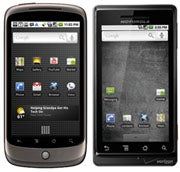Jan 15, 2010 6:04 pm
 Google Nexus One and the Droid.
Google Nexus One and the Droid.Motorola can add one more item onto its list of Droid slogans: Droid does have more expensive hardware than the Nexus One. But only by a small margin.
A new teardown analysis finds Motorola's flagship Android device has $179.11 worth of components inside. Google's Nexus One, on the other hand, has $174.15 worth of goodies beneath its shiny shell, according to the same company. That difference is despite the fact that the Nexus One boasts a faster processor and twice the RAM of its Motorola-made contemporary.
Now, does this finding do anything to change the value of the phones from a consumer perspective? Of course not. But for anyone intrigued by Android, it does make for some interesting trivia.
Inside the Nexus One
So here's the scoop, starting with the Nexus One. Google's high-profile phone went under the knife earlier this week. The surgeon -- a company called iSuppli -- reached its $174.15 conclusion by analyzing every piece of hardware inside the phone.
As one might expect, the Nexus One's processor -- the superfast 1 GHz Snapdragon -- is its most expensive component, accounting for $30.50 of its total bill of materials. The phone's display comes in next, with an estimated cost of $23.50. That's followed by the memory ($20.40), touchscreen assembly ($17.50), camera ($12.50), and then a host of other assorted parts.
Dissecting the Droid
The Droid, in comparison, has a very different bill. According to iSuppli, its most expensive component is its 16GB microSD card, coming in at $35. (The Nexus One is equipped with only a 4GB microSD card; both phones, however, can be upgraded to cards as high as 32GB.)
Following the card is the phone's 3.7-inch TFT LCD display, which is estimated to cost $17.75. While the Droid's display is generally regarded as being one of the best on the market, the fact that it's TFT LCD is likely why it's lower in cost than the Nexus One's OLED alternative. You can see more about the differences between those two technologies in my "Nexus One Questions and Answers" report.
Continuing downward, the Droid has a $17.50 touchscreen overlay, $14.25 camera, $14.04 baseband processor, and $12.90 applications processor. The grand total comes out to about $4.96 more than what's inside the Nexus One.
You can see iSuppli's full component breakdown for the Droid here, and for the Nexus One here. And if you own either handset, be sure to also click over to "Master Google Android: 40 Tips and Tricks," my in-depth guide to making the most of your Android experience.









